|
Introduction to a Multimedia History of Privacy Privacy, Publicity, and Power
While
privacy is now commonly regarded as one of the most cherished values in American
society, hardly anyone has tried to
This book is accordingly designed to illuminate the historical role of technology in the evolution of claims to privacy. However, what distinguishes this study from previous works on privacy is not only that it adopts an historical approach, but also that it invites and, in some cases, obliges readers to view and listen to the multimedia materials that are cited throughout the text. After all, by using the same technology that has pushed electronic privacy to the forefront of political discussion, we can incorporate visual, audio, and textual evidence directly into the presentation of scholarly work. Now that we have gained this remarkable ability, it hardly makes sense for scholars to translate primary materials such as photographs, films, and political speeches into secondary texts. Consequently, wherever possible, I have hyperlinked sound recordings, video clips, legal documents, government forms, and other sources directly to my arguments. By taking full advantage of this new technology, I hope to illustrate how our increasing capacity to collect and convey information has transformed popular views of the public/private dichotomy and, consequently, prevailing perceptions of what should be accepted as historical evidence. With this in mind, the main premise of this study is that advances in communications technology have expanded and intensified the exchange of information both between the past and the present and among the existing members of society. Today, we routinely send and receive information about ourselves and others via letters, newspapers, magazines, journals, books, telephones, radio, movies, television, faxes, video tapes, CD's, DVD's, computer disks, and the Internet. Moreover, as the means to store and retrieve this information almost instantly from anywhere has improved, the volume and availability of documentary evidence of personal characteristics and conduct have boomed. One of the outcomes of this technological revolution is that we have become increasingly familiar with the intimate lives of total strangers. Indeed, it could be argued that the most striking aspect of common knowledge in twenty-first century American society is that so much of it revolves around the personal lives of people whom we have never met. As the extension of intimacy engendered by communications technology has enlarged what we know about strangers living in our own time, it has, not surprisingly, reshaped the questions we ask about historical figures. For example, in stark contrast to any of J. Edgar Hoover's contemporaries, we would probably find fault or least take note if a current writer on his life failed to comment on reports that he was a homosexual.1s The point is not that such a biographer would be obliged either to uphold or dismiss this information, but that the omission of all commentary on the subject would suggest that the writer had failed to address an important aspect of Hoover's life. Of course, this example could be multiplied almost endlessly--we have only to bring to mind what we have been told about Thomas Jefferson, Eleanor Roosevelt, or John F. Kennedy.2s Again, the purpose in mentioning these figures is not to judge whether what we have learned about these people is true, but to suggest that the sense of familiarity induced by communications technology has shifted the boundaries between public and private, both in existing society and in the study of history.  One way to clarify this premise and to indicate how primary documents will figure in this study is to examine a particularly telling and, from our standpoint, failed claim to privacy: Franklin Delano Roosevelt's decades-long effort to conceal the effects of his bout with polio. More specifically, we can see how technology transformed the public/private dichotomy by looking at F.D.R.'s Report to Congress in 1945. Having just returned from meetings with Allied leaders in Yalta, Roosevelt did not stand to deliver his address. Instead, he sat at a table in the well of Congress and spoke into a crowd of microphones. Despite its political purpose, Roosevelt’s speech on Yalta is now widely remembered, not for his remarks on the division of power in Europe, but for his explicit admission of his physical disability. What makes this moment stand out in the development of ideas about privacy is not simply that a powerful public figure mentioned a condition that he had previously gone to remarkable lengths to conceal. Rather, what is most important about this moment is the way in which it was designed to be captured by a camera. Roosevelt was not, after all, revealing his physical condition to anyone present in the hall. The members of Congress and those reporting on the event had watched him being wheeled to his seat behind the table, and many had undoubtedly seen him sitting in his wheelchair before. The President’s request to be forgiven for his “unusual posture” was thus directed, not to the “gentlemen” who were actually there, but to the viewers who would see him as he appeared on film. It is, moreover, important to note that Roosevelt did not abandon his deception. Rather, he attributed the fact that he was seated to weariness brought on by his recent journey. In other words, he continued to hide, at least from the newsreel audience, what countless people who had observed him in person understood, namely, that he had not been able to stand on his own for years. (3s) Roosevelt’s calculated concession to the camera exemplifies the role of technology in the demarcation of the public/private divide. Throughout the first half of the twentieth century, as multitudes gained access to newspapers, photographs, moving images, sound recordings, telegraphs, and telephones, it became increasingly difficult for individuals to control the dissemination of information about their physical characteristics and personal histories. Consequently, as technological development supplied new ways to record and transmit information, political leaders, public figures, and ordinary people sought new ways to shape public knowledge of personal life. From this perspective, we can see that Roosevelt brought up the “ten pounds of steel” that he had worn around his legs not because he wanted to broadcast details of his disability, but because the presence of the camera required him to reassert his desire to limit public awareness of his handicap. He accordingly offered his highly staged apology to Congress not as a confession, but as a signal that he wanted to keep those who would watch him on film from seeing the nature and extent of his illness. Of course, in 1945, almost no one would think of rejecting this sort of tacit appeal for privacy, and the film displays exactly the response that Roosevelt apparently expected: a vigorous round of applause.
In order to gage how much the public/private
split has changed in recent decades, we can contrast the film of Roosevelt’s
Report to Congress with the way he is currently portrayed at the Roosevelt
Memorial in Washington,
The gulf between Roosevelt's performance before Congress in 1945 and the way he is currently memorialized indicates how the boundaries between public and private shifted in the course of the twentieth century. In Roosevelt's time, before cameras became ubiquitous in both public and private spaces, it was still relatively easy for public figures to cordon off their private lives. While the private circles of socially significant people were filled with family members, friends, assistants, servants, hangers-on, and assorted underlings, the social expectations defined by gender, race, class, and other inequalities would determine what would or would not be carried into public view. However, as newsreels and, much more profoundly, television inured the public to the sight of presidents, movie stars, and other prominent figures occupying easy chairs, relaxing on lawns, splashing in pools, and otherwise enjoying leisurely moments, the disciplines that had defined social distance gradually dissolved. The effect of this increasing proximity was not, as the rise of popular culture is often described, that the public sphere grew to include more people, but that the private sphere gradually took in millions. On one hand, communications technology gave ordinary individuals access to the private realms of prominent people; on the other, television, video players and, more recently, the Internet enabled us to experience seemingly intimate moments with complete strangers in the comfort or, as the case may be, discomfort of our homes.
As a result of this relatively new form of
social interaction, the sense of solitude surrounding the sculpture of F.D.R. no
longer seems strikingly out of place even in a public monument. Since his
death, we have come to know much more about Roosevelt's personality than the
general public
Of course, this expectation could only have
arisen in a world in which communications technology had made it possible for us
to record and transmit what goes on in the private sphere. Thanks to the
proliferation of audio and visual recording devices, our perceptions of other
people's private lives are based not on idle gossip or empty speculation, but on
documentary evidence. In fact, in the course of the twentieth century,
photography so inured us to seeing people in seemingly private or even solitary
situations that these intimate scenes displaced public performance as most
representative of shared
Now that we are awash in so much information
about private activity, it makes sense that we would commemorate Roosevelt by
building a monument to an aspect of his person that he doggedly attempted to
hide. In a society in which public actors are assumed to be pandering to the
camera, what seems most instructive is not what historical figures did when they
knew they were in public, but how they felt and behaved when they apparently
believed that we could not see them. Thus, of the tens of thousands of pictures
of F.D.R. that are collected in public archives, only two depict him in his
wheelchair and, although neither of these images circulated publicly in his
lifetime, they became the basis for the wheelchair sculpture.
(5s)
This national celebration of a previously
private condition illustrates how our capacity to gather and circulate personal
information has remade prevailing perceptions of the private sphere. As
increasing access to the private lives of public figures inspired us to focus on
personal conduct rather than public display, the private realm, which used to be
seen as a place of confinement, came to be viewed as the realm of
self-realization, not only for those of us who have nowhere else to achieve it,
but also for people who occupy prominent positions in the public eye. What
truly distinguishes these people from the rest of us is, consequently, not
simply that their public accomplishments are grander or more substantial than
ours will ever be. Instead, their private lives also seem to be much more
momentous.
The chapters that follow trace the route that led to this ironic formulation of the public and private spheres. However, having come to appreciate both the enormous scope of this subject and the fantastic number of documents that could be used to explore it, I have attempted to address only the most basic and obvious issues in the evolution of current conceptions of private life. For example, Chapter One examines what is by far the most frequently cited essay on the subject in American history, Brandeis and Warren's "The Right to Privacy." There I draw on the insights of legal theorists and feminist scholars, but rather than attempting to improve on their interpretations, I focus on the way technological progress, along with the woman suffrage movement, inspired Brandeis and Warren to redefine and reinforce the importance of the private realm. Similarly, in subsequent chapters on the welfare state, the Cold War, the age of television, the sexual revolution, the Reagan era, the Internet, and tell-all culture, I refer to secondary literature, but my central concern is to show how the historical interactions between technology and privacy both informed and reflected mainstream currents in American politics, culture, and society. To this end, I have gathered a vast collection of primary documents that illuminate the role of privacy at critical moments in American history. Some of these are typical historical texts such as Supreme Court rulings, scholarly writings, and newspaper accounts. Others are artifacts of everyday life and popular culture that have yet to be recognized within the radar of historical scholarship. Some of these include facsimiles of government forms such as applications for welfare and other benefits, video clips of movie stars and other relatively ephemeral figures, and links to the personal web pages of otherwise unknown individuals. Moreover, wherever possible, I have hyperlinked complete texts, as well as audio and visual materials, to my arguments. While I don't expect readers to delve into all of these documents, one of my aims in this book is to show how the increasing availability of evidence is changing both our notions of privacy and the nature of historical research. Information technology has enabled us not simply to access oceans of textual, audio, and visual materials, but also to view wildly disparate documents at the same time. For instance, on the same screen, we can compare Brandeis and Warren's late nineteenth-century observations on privacy with Bill Clinton's late-twentieth-century insistence that, "Even presidents have private lives." (3) (4) Likewise, we can read or even listen to one of Margaret Sanger's speeches on contraception and then play audio recordings of the arguments that the Supreme Court heard in Roe v. Wade. (5) (6) I am not trying to promote the scholarly equivalent of simultaneously shopping, drinking coffee, and talking on the phone. However, I am trying to demonstrate how new ways to collect, retrieve, and broadcast information can change both how we see and what we see when we look at historical records. Finally, as a writer on the history of political ideas, I try to maximize the accuracy of my presentation of historical developments and events. Now that we can capture and disseminate the tone of a public figure's voice in a dramatic announcement, the expression of a witness to an historical moment, the full text of a significant legal opinion, or an exact copy of a remarkable photograph, it would be almost irresponsible to reduce these materials to second-hand descriptions. Moreover, since it has become possible to transmit sources that were once seen only by scholars to the general public, readers can now scrutinize almost all of the documents we use to support our arguments. Information technology has thus enabled us to transport the relatively private and often inaccessible world of serious scholarship into the public sphere. In the chapters that follow, I have undoubtedly slipped into the privatizing jargon of academic discourse, but since my goal is to promote the widest possible discussion of the public/private dichotomy, I have done my best not only to write in an accessible style, but also to make it easy for readers to rifle through all of the evidence that has informed my reading of the role of privacy in American politics. |
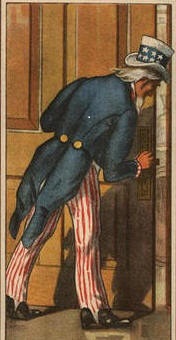
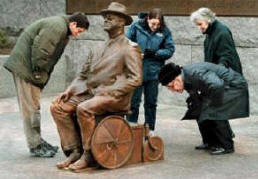
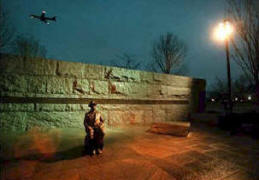 see him as he would have appeared in a private hour. No matter how many
tourists crowd into the site, there is no escaping the sensation that we are
looking at a statue of a person who thinks he is alone.
see him as he would have appeared in a private hour. No matter how many
tourists crowd into the site, there is no escaping the sensation that we are
looking at a statue of a person who thinks he is alone.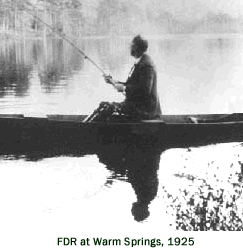 knew
in his lifetime. If we surf the Web, we can see him playing with his dog,
fishing on a lake, waving from a sailboat, and, of course, sitting in his
wheelchair.
knew
in his lifetime. If we surf the Web, we can see him playing with his dog,
fishing on a lake, waving from a sailboat, and, of course, sitting in his
wheelchair. For us,
the real truth lies behind the scenes, off the record, in casual disclosures and
unplanned remarks. We accordingly expect to see Roosevelt not as he appeared
when he was acting as our President, but as he was in real life.
For us,
the real truth lies behind the scenes, off the record, in casual disclosures and
unplanned remarks. We accordingly expect to see Roosevelt not as he appeared
when he was acting as our President, but as he was in real life.
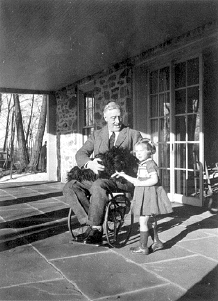
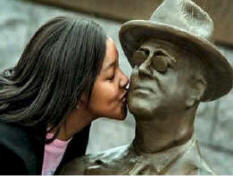 Indeed,
the private struggles of figures such as Roosevelt are seen as so significant
that they have assumed monumental portions. It is, in fact, hard to imagine how
millions of people could crowd into the psychic space that used to be reserved
for F.D.R.'s inner circle if the details of his private life had not been
photographed, broadcast, scrutinized, and then sculpted for public exhibition.
Communications technology accordingly redefined the public/private dichotomy,
first by promoting the notion that private behavior and personal qualities are
more meaningful than public conduct, and then by providing us with the means to
display that behavior and those qualities to an ever larger audience.
Indeed,
the private struggles of figures such as Roosevelt are seen as so significant
that they have assumed monumental portions. It is, in fact, hard to imagine how
millions of people could crowd into the psychic space that used to be reserved
for F.D.R.'s inner circle if the details of his private life had not been
photographed, broadcast, scrutinized, and then sculpted for public exhibition.
Communications technology accordingly redefined the public/private dichotomy,
first by promoting the notion that private behavior and personal qualities are
more meaningful than public conduct, and then by providing us with the means to
display that behavior and those qualities to an ever larger audience.